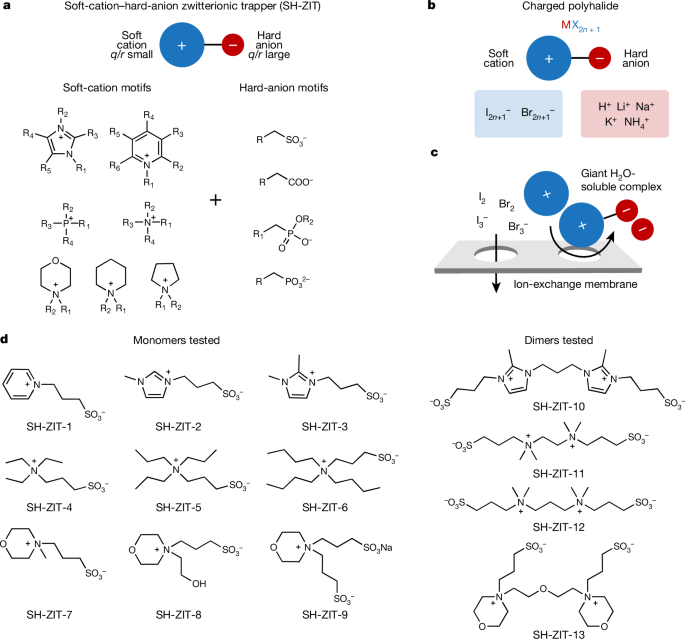Li, B. et al. Ambipolar zinc-polyiodide electrolyte for a high-energy density aqueous redox flow battery. Nat. Commun. 6, 6303 (2015).
Küttinger, M., Loichet Torres, P. A., Meyer, E., Fischer, P. & Tübke, J. Systematic study of quaternary ammonium cations for bromine sequestering application in high energy density electrolytes for hydrogen bromine redox flow batteries. Molecules 26, 2721 (2021).
Küttinger, M., Loichet Torres, P. A., Meyer, E. & Fischer, P. Properties of bromine fused salts based on quaternary ammonium molecules and their relevance for use in a hydrogen bromine redox flow battery. Chem. Eur. J. 28, e202103491 (2022).
Sonnenberg, K., Mann, L., Redeker, F. A., Schmidt, B. & Riedel, S. Polyhalogen and polyinterhalogen anions from fluorine to iodine. Angew. Chem. Int. Ed. 59, 5464â5493 (2020).
Svensson, P. H. & Kloo, L. Synthesis, structure, and bonding in polyiodide and metal iodideâiodine systems. Chem. Rev. 103, 1649â1684 (2003).
Liebhafsky, H. A. The equilibrium constant of the bromine hydrolysis and its variation with temperature. J. Am. Chem. Soc. 56, 1500â1505 (2002).
Jiménez-Blasco, U., Arrebola, J. C. & Caballero, A. Recent advances in bromine complexing agents for zincâbromine redox flow batteries. Materials 16, 7482 (2023).
Zhang, D., Liu, Q., Shi, X. & Li, Y. Tetrabutylammonium hexafluorophosphate and 1-ethyl-3-methyl imidazolium hexafluorophosphate ionic liquids as supporting electrolytes for non-aqueous vanadium redox flow batteries. J. Power Sources 203, 201â205 (2012).
Bryans, D., McMillan, B. G., Spicer, M., Wark, A. & Berlouis, L. Complexing additives to reduce the immiscible phase formed in the hybrid ZnBr2 flow battery. J. Electrochem. Soc. 164, A3342âA3348 (2017).
Bellows, R. et al. Development of a Circulating Zinc-Bromine Battery. Phase I. Final Report. Sandia National Laboratories, US Department of Energy (1983).
Pearson, R. G. Hard and soft acids and bases. J. Am. Chem. Soc. 85, 3533â3539 (1963).
Pearson, R. G. The HSAB principleâmore quantitative aspects. Inorg. Chim. Acta 240, 93â98 (1995).
Luo, T., Abdu, S. & Wessling, M. Selectivity of ion exchange membranes: a review. J. Membr. Sci. 555, 429â454 (2018).
Chen, X. et al. Raman spectroscopic investigation of tetraethylammonium polybromides. Inorg. Chem. 49, 8684â8689 (2010).
Kalina, D. W., Lyding, J. W., Ratajack, M. T., Kannewurf, C. R. & Marks, T. J. Bromine as a partial oxidant. Oxidation state and charge transport in brominated nickel and palladium bis(diphenylglyoximates). A comparison with the iodinated materials and resonance Raman structure-spectra correlations for polybromides. J. Am. Chem. Soc. 102, 7854â7862 (1980).
Evans, J. C. & Lo, G. Y. S. Vibrational spectra of BrOâ, BrO2â, Br3â, and Br5. Inorg. Chem. 6, 1483â1486 (1967).
Bauer, G., Drobits, J., Fabjan, C., Mikosch, H. & Schuster, P. Raman spectroscopic study of the bromine storing complex phase in a zinc-flow battery. J. Electroanal. Chem. 427, 123â128 (1997).
DeBruler, C., Hu, B., Moss, J., Luo, J. & Liu, T. L. A sulfonate-functionalized viologen enabling neutral cation exchange, aqueous organic redox flow batteries toward renewable energy storage. ACS Energy Lett. 3, 663â668 (2018).
Bursch, M., Mewes, J., Hansen, A. & Grimme, S. Bestâpractice DFT protocols for basic molecular computational chemistry. Angew. Chem. Int. Ed. 61, e202205735 (2022).
Pracht, P., Bohle, F. & Grimme, S. Automated exploration of the low-energy chemical space with fast quantum chemical methods. Phys. Chem. Chem. Phys. 22, 7169â7192 (2020).
Grimme, S. Exploration of chemical compound, conformer, and reaction space with meta-dynamics simulations based on tight-binding quantum chemical calculations. J. Chem. Theory Comput. 15, 2847â2862 (2019).
Grimme, S., Hansen, A., Ehlert, S. & Mewes, J.-M. r2SCAN-3c: a âSwiss army knifeâ composite electronic-structure method. J. Chem. Phys. 154, 064103 (2021).
Zhao, Y. & Truhlar, D. G. The M06 suite of density functionals for main group thermochemistry, thermochemical kinetics, noncovalent interactions, excited states, and transition elements: two new functionals and systematic testing of four M06-class functionals and 12 other functionals. Theor. Chem. Acc. 120, 215â241 (2008).
Grimme, S., Antony, J., Ehrlich, S. & Krieg, H. A consistent and accurate ab initio parametrization of density functional dispersion correction (DFT-D) for the 94 elements HâPu. J. Chem. Phys. 132, 154104 (2010).
Barone, V. & Cossi, M. Quantum calculation of molecular energies and energy gradients in solution by a conductor solvent model. J. Phys. Chem. A 102, 1995â2001 (1998).
Frisch, M. J. et al. Gaussian 16, Revision C.01 (Gaussian Inc., 2016).
Weigend, F. & Ahlrichs, R. Balanced basis sets of split valence, triple zeta valence and quadruple zeta valence quality for H to Rn: design and assessment of accuracy. Phys. Chem. Chem. Phys. 7, 3297â3305 (2005).
Rappoport, D. & Furche, F. Property-optimized Gaussian basis sets for molecular response calculations. J. Chem. Phys. 133, 134105 (2010).
Pritchard, B. P., Altarawy, D., Didier, B., Gibson, T. D. & Windus, T. L. New basis set exchange: an open, up-to-date resource for the molecular sciences community. J. Chem. Inf. Model. 59, 4814â4820 (2019).
Amzel, L. M. Loss of translational entropy in binding, folding, and catalysis. Proteins 28, 144â149 (1997).
Marenich, A. V., Cramer, C. J. & Truhlar, D. G. Universal solvation model based on solute electron density and on a continuum model of the solvent defined by the bulk dielectric constant and atomic surface tensions. J. Phys. Chem. B 113, 6378â6396 (2009).
Griffith, R. O., McKeown, A. & Winn, A. G. The bromineâbromide-tribromide equilibrium. Trans. Faraday Soc. 28, 101â107 (1932).
Li, M. et al. Experimental protocols for studying organic non-aqueous redox flow batteries. ACS Energy Lett. 6, 3932â3943 (2021).
Lv, X. L. et al. Dextrosil-viologen: a robust and sustainable anolyte for aqueous organic redox flow batteries. ACS Energy Lett. 7, 2428â2434 (2022).
Lv, X. L. et al. Modular dimerization of organic radicals for stable and dense flow battery catholyte. Nat. Energy 8, 1109â1118 (2023).


